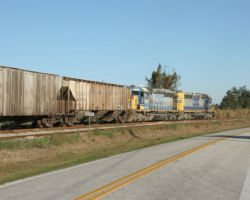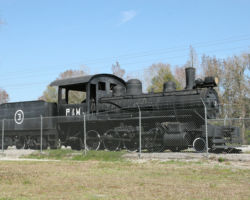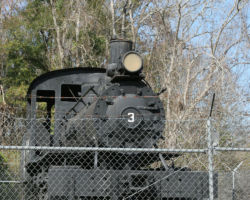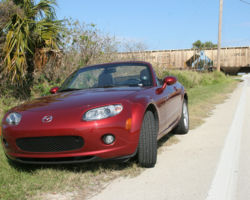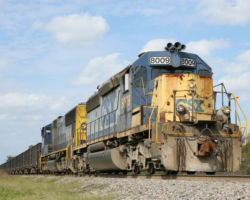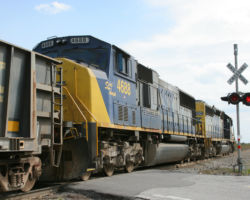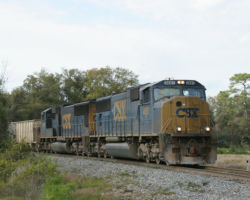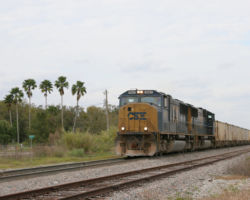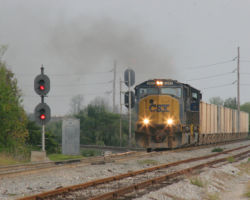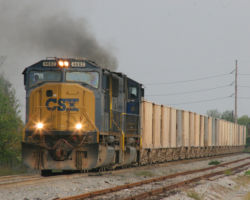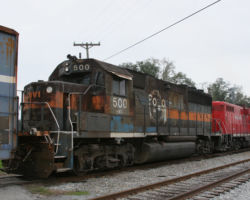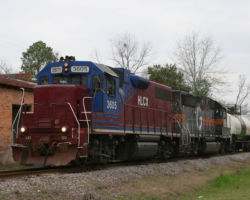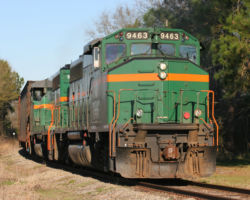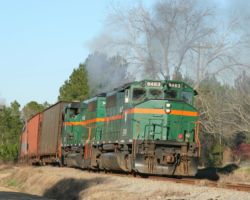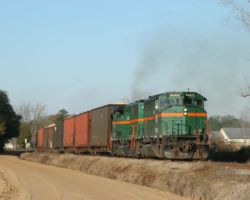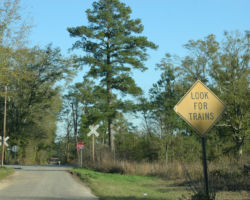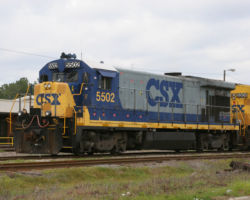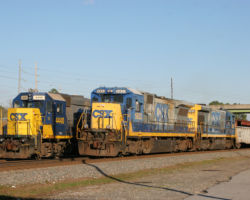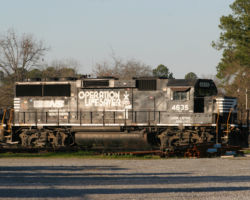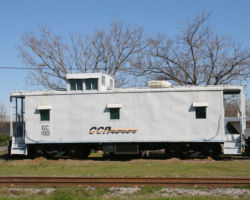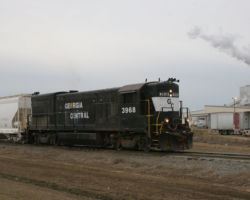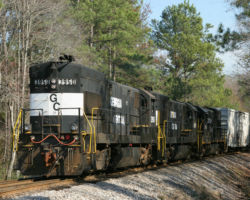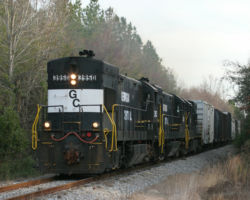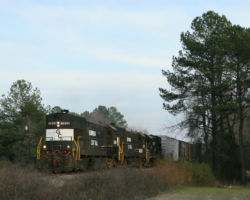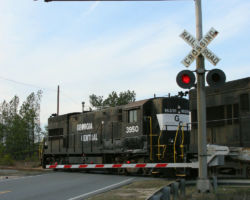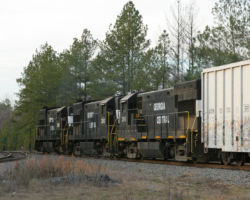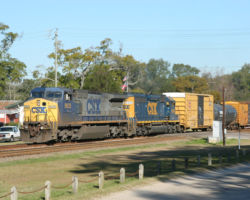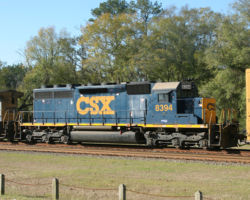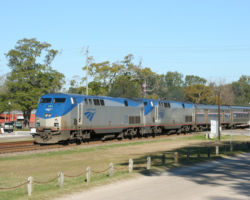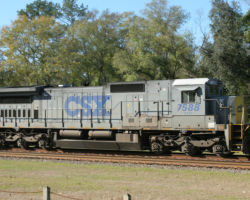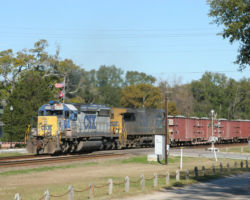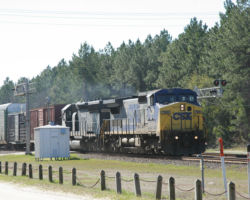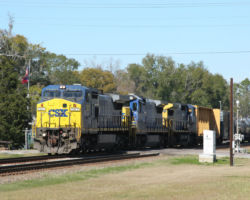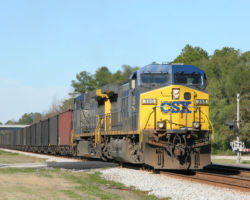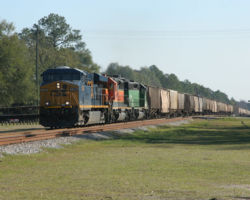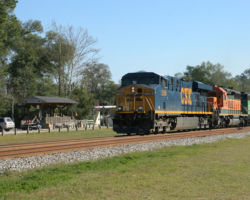Florida’s Bone Valley – Saturday, Jan 20, 2007
Nearly five years ago, I spent about two weeks running around Tampa and discovering CSX’s extensive operations out in the Bone Valley – a phosphate mining region approximately half an hour east of Tampa. To see photos and notes from that trip, have a look at the first couple chapters from that trip report. This time, I’d actually be working up in Tallahassee, but I had a weekend to kill between flying in and actually having to do any work. I actually flew into Jacksonville, and headed down state early Saturday morning. I figured since I only had a day or so before I needed to head into Tallahassee, somewhere with a lot of Class I trains would be the best, since shortlines don’t tend to work weekends. CSX’s Bone Valley operations fit the bill nicely. Better yet, the weather was promising to be warm and clear down around Tampa, so off I went.
That Saturday actually turned out to be a bit of a bust. Despite spending most of the day zipping around the area, checking and rechecking mines, junctions, and the Mulberry yard at the hub of it all, I came up with two lousy trains. The first was a single SD70M that brought a cut of cars from Mulberry out to the Nichols yard, and then immediately returned light. The other was a pair of SD40-2s that ran east out of Mulberry – away from the sun – and went in to switch the plant north of Hwy 60 near Bartow until well after dark. Like I said, pretty much a bust, although the weather was beautiful and it was good to familiarize myself with the region again.
Unfortunately, since this was, after all, a work trip, I did have to head for Tallahassee on Sunday morning so that I could be around for work that evening. The west coast of Florida is now largely devoid of railways, since the Florida West Coast ripped up its last few miles of track. I did find one relic on the drive north, however – a small Vulcan 2-8-0 in a roadside park at Gulf Hammock, FL. The unit apparently originally belonged to a local logging operation called Patterson & McInnis. That’s about all I know of the unit’s heritage, though.
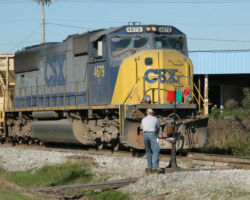
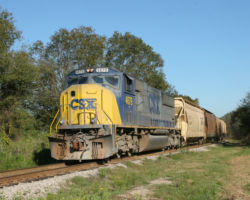
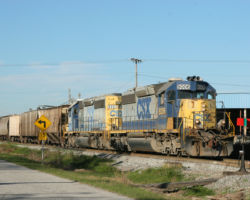
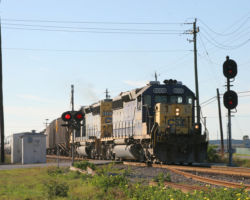
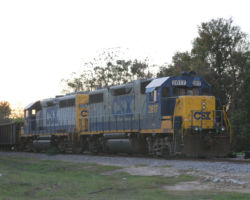
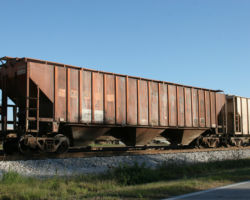
Florida’s Bone Valley, Round 2 – Saturday, Jan 27, 2007
After finishing up with work the next Friday (26-Jan-2007), I took the rental car back to Jacksonville. It has to do with work and insurance, but suffice to say I have to switch cars once I’m done with work and on personal time. Let’s start with a basic assumption – most car rental companies seem to do their dead level best to screw things up. Figuring I’d be in Florida for nearly a week after I was done with work, and figuring it’d be warm (or at least warmer than Colorado), I put a reservation on a convertible. Let’s face it, I haven’t gotten to really drive mine in months, and I’m getting a little twitchy for the open air driving experience. However, guess what they didn’t have when I arrived to pick it up on Friday? Tada, if you said the car I had a reservation for, you’d be a winner. For reference, this was a national chain whose name might be synonymous with “el friggin’ cheapo” and has a dark blue as their logo color… The alternate choices I got? A Crossfire for a whooooole lot more money, or Chrysler 300. Maybe an SUV? Thanks, but no thanks.
So, I cancel that reservation and start pondering what to do. I realize I should just go talk to Hertz, since they’ve always come through for me in the past, though they do tend to put a bigger dent in the ol’ credit card to do so. I walk down and start talking to the lady at the counter, and I mention what’s happened. She’s happy to give me my corporate rate, and offers me back the car that I’d just turned in (a nicely powered Mazda 6). Just on a whim, I ask about convertibles. She replies, “No, I’m sorry, we don’t have any of the Mustangs left.”
“Oh well, that’ll be okay, I’ll just take my Mazda back.”
“Well, they’re really small, but if you’re really wanting a convertable, we do have a couple Miatas out there…”
At that point, my jaw hit the floor and I think I started jumping up and down like an overexcited schoolgirl. Well, aside from the fact I don’t have pigtails, nor could I in any way be considered cute. And I don’t wear skirts. This confused the counter agent a bit, as apparently the couple people that had rented them returned them as being too tiny. 20 minutes later, I was comfortably seated in a red 2006 MX-5 Miata, top down, radio cranked, and rolling southward on I-295. With the size of grin on my face, it’s a wonder I didn’t catch a few bugs in the process. It’s amazing how much happiness the right car can bring. Next stop – Orlando, then the Bone Valley. A nice, relaxing Saturday with phosphate trains, driving around in the sun with the top down, and 75ish degree temps. What moron would want to go to the beach instead? *grin*
This Saturday in the Bone Valley was a little more successful, starting off immediately with an eastbound string of empties moving out of Mulberry. Mining appears to have slowed a bit since the last time I was down, though. I heard several mentions through local media about some of Mosaic’s mines being closed recently, and I suspect this has something to do with it. There just don’t seem to be as many trains out running around at any given time. Five years ago, you could almost always find one out and moving. This trip, it was actually a bit challenging to find an operating train. Might have also been a function of it being a weekend, as well, since last time I was there during the week.
There’s not much else to say – the morning was nice, warm, and sunny, but the weather turned to clouds and rain as the day wore on. Nonetheless, I was in the BV pretty much from morning until after dark, and even with fewer trains, it’s still a fun place to photograph. To anybody visiting the Tampa area, it should be on the “must visit” list for at least a day.
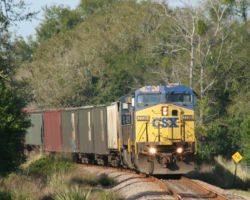
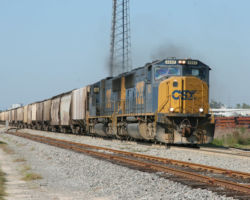
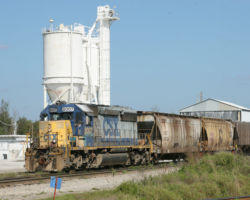
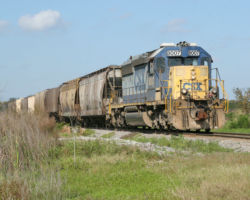
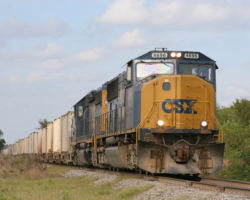
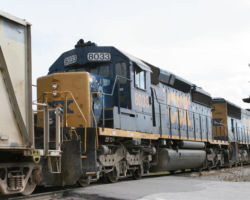
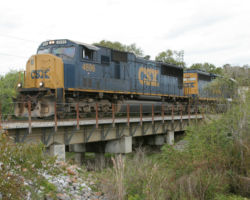
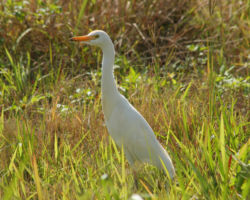
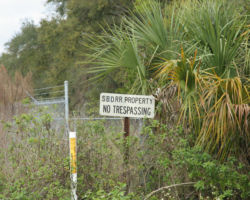
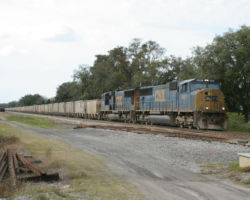
Georgia & Florida Railnet – Wed/Thurs, Jan 24-25, 2007
The Georgia & Florida Railnet is a small regional railroad that operates some 296 miles of track in southern Georgia down into the Florida Panhandle region. The system is arranged into four main routes – Albany, GA, to Thomasville, GA; Albany, GA, to Foley, FL; Albany, GA, to Sylvester, GA; and Valdosta, GA, to Willacoochee, GA. In addition, the GFRR has trackage rights via NS to bridge a gap of the Albany-Foley route between Sparks and Adel, GA, as well as to connect it with the isolated Valdosta-Willacoochee line. The route is pieced together from a number of original lines, with a history too complex to cover here.
The motive power fleet is mostly rent-a-wrecks and a dozen or so Railnet-painted units. Most notable are the four GFRR GP40-2LW ex-CN widecabs, painted in a very attractive green and orange scheme. At the time this is written, these units seem to be confined to the Albany, GA, to Perry/Foley, FL, route. There are also a number of rebuilt early GPs (7s and 9s), painted in a solid red scheme. On the downside, though, there are a number of units on the road that look as if they’re powered by pure liquid ugly – mostly some ex-Guilford (exx-B&M) GP40-2s, running under HALX reporting marks. There are also a couple of ex-Railnet GEs on the property as well, but I’m not sure if they still run.
Carrying a scanner is very important while railfanning down in the southeast. Many times, the lines are only a couple hundred feet off the road, but so totally obscured by trees that a train could be over there and you’d never know it. The GFRR is a very chatty road when they’re switching, but relatively quiet otherwise. Their two main road frequencies are 160.500 MHz and 161.190 MHz. I’d also advise you monitor the FRED frequency at 457.9375 MHz, as the road trains carry FREDs and you’ll start hearing blips when a train is nearby. Also, remember that Florida has an assinine anti-scanner law, so don’t be using that there scanner in Florida unless you’re a licensed ham operator. Well, at least be ready to turn it off and chuck it under the seat should law enforcement decide to stop by, lest you may lose your scanner and wind up with a ticket.
What follows are my observations about operations. They’re not necessarily accurate, but it’s what I observed and think I figured out about their day-to-day operations. Hopefully it’ll help those who follow me.
Operations for the two main routes – Albany-Thomasville and Albany-Foley – seem to be relay-type setups, where crews start at each end of the railroad and work their trains towards a meeting point in the middle, where they exchange trains and the crews work back home. For the east route, this meeting point is a small yard in Adel, just south of the I-75 overpass. For the west line, the trains seem to hand off at Camilla. Both meets seem to occur in the early afternoon – around 1300h-ish. As far as the Valdosta branch, I tried several times, but never found a running train, nor any sign that any train had run. The rails were also extremely rusted north of Ray City, so I’m not sure how often they even make it out that far.
One unique operation I witnessed was at Schley Junction, just northwest of Moultrie. There, the mainline meets the branch that actually runs through town. The main runs around the northeast side on a sort of bypass track. While I was there, a local met the road train and interchanged cars for the three mile run back to town, while the road train continued east on the bypass towards Sparks.
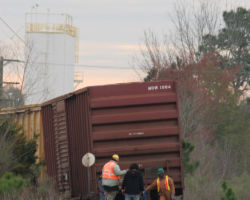
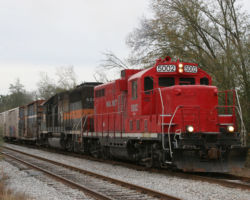
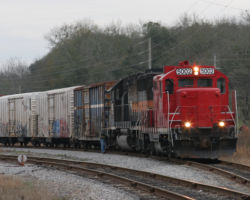
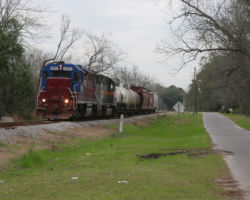
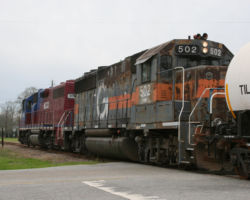
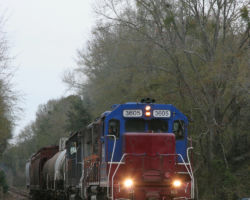
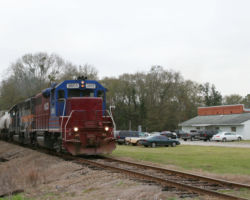
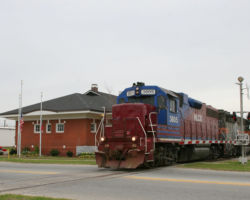
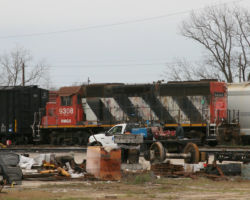
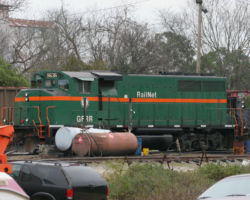
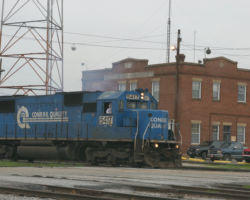
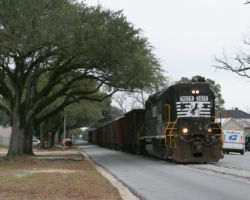
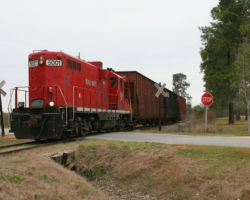
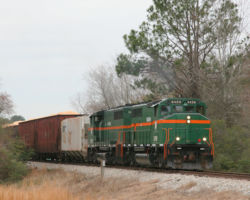
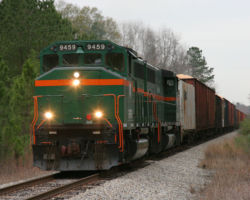
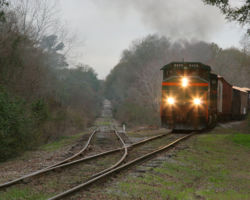
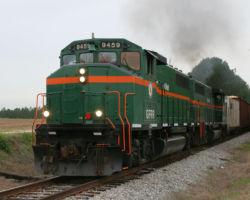
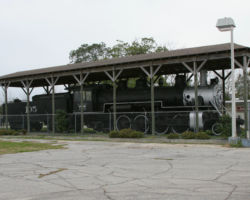
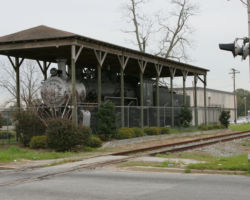
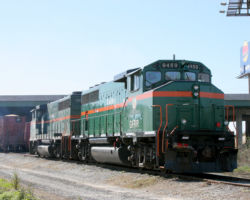
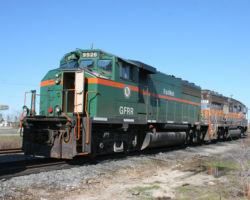
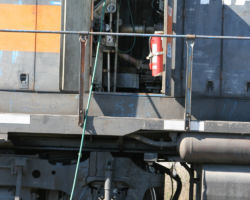
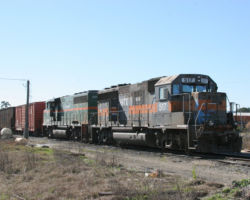
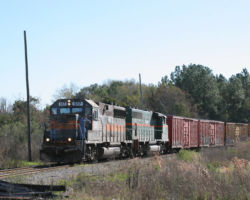
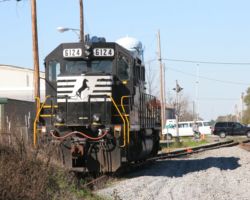
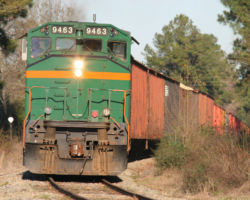
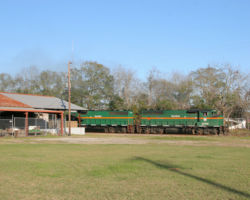
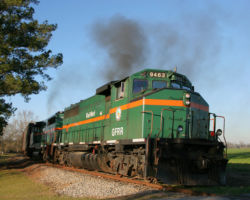
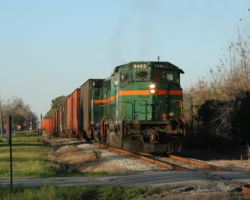
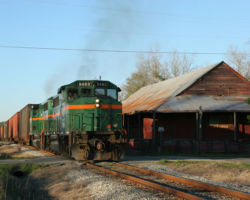
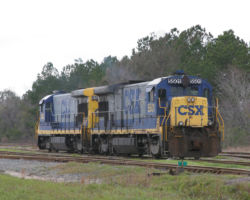
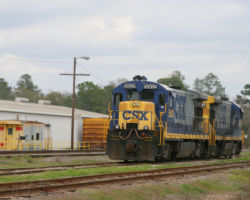
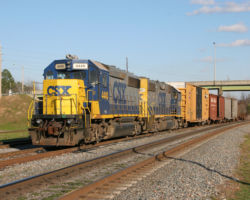
The Georgia Central – Sun-Tues, Jan 28-30, 2007
The Georgia Central enjoys a unique place amongst short lines, with a roster almost exclusively consisting of first-generation GE U-boats. They run nearly 200 miles of line, crossing central Georgia from Macon to Savannah. The line interchanges with NS on the west end and CSXT on the east. There’s also a connection to an NS branch at Dublin, and the Heart of Georgia Railroad (the HOG) at Vidalia. While the track is still intact, I’m told the HOG no longer runs all the way to Vidalia, though, so don’t expect to see them out there.
For a quick history lesson, the route from Macon to Vidalia was originally built by the Macon, Dublin and Savannah Railroad between 1891-1902. Vidalia to Lyons was built by the Savannah, Americus & Montgomery in 1890, connecting at Lyons with the Savannah and Western on into Savannah, GA. The whole thing eventually wound up under the Seaboard Air Line, which in merger with the ACL became Seaboard Coast Line, which in turn eventually became CSX. Sometime in the mid-1990s, these lines were spun off to the Georgia Central Railway. The GCR of today is a part of Rail Link, itself a subsidiary of the Genesee & Wyoming family of railroads.
The GCR is the only shortline I know of that not only rosters a large number of classic GE U-boats, but they’re even unusual for that. Most of their fleet consists of ex-Southern Railway U23Bs with high short hoods, set up to run long hood first. They’re all painted in the road’s NS-esque black and white scheme, with “Georgia Central” on the side. The O in Georgia is a peach, though on many of the units, the graphic has faded badly. In addition to the high nose U23Bs that form the backbone of the roster, they also have a single short nose U23B and a pair of U30Bs and some assorted EMD stuff. This roster should give you a general idea of what you can expect.
Over-the-road operations seem to be sparse over much of the system, so expect to spend a few rather unrewarding days to actually get some shots of the GCR in action. The GCR’s main road trains originate from yards at both ends of the system. The yard at Macon is immediately adjacent to Central City Park, and power is often parked up at the north end when not in use. While sitting there, it’s easily photographed from public park areas (though light is best in the morning). One note – they seem to be rather vigilent about trespassers – particularly around Macon – so be a good railfan and stay on public property, or at least ask permission. Road trains from the other end start at the GCR’s yard in Savannah, easily found by taking exit 4 from I-516. There’s not a lot to see, but it’s a good place to see if they’re assembling an outbound train. This seems to be a rather rough neighborhood, so be careful.
My experience is that the eastbound train out of Macon is put together in the midday, then hauled up to the yard limit, just shy of the Georgia Hwy 307 crossing (north of exit 160 from I-16). The yard crew then seems to drop the train for the road job. No idea when it goes on duty, but this train is almost always parked short of the grade crossing by the main shops east of Lyons, GA, by the middle of the next morning. As best I can tell, the train proceeds west from Lyons in the mid-afternoon (say, 1500h-1600h), working west to eventually switch the Dublin yard.
The GCR has local switchers stationed at Dublin and Vidalia. These are usually just a single U23B. The Dublin job seems to work weekdays, coming on duty around 0800h-ish, but it spends its entire day inside a papermill just southeast of town. I have no idea what the Vidalia job does – it didn’t move during the three days I spent on the line.
On the west end of the system, the Macon job is reported to go on duty at 0700h, but in my experience, they usually started later – well after 0800h. It might just be a seasonal (or daily) variance, based on the amount of work to do. They usually switch the yard for a while, and then often head up to the Georgia Kaolin plant near Dry Creek. There’s no way to shoot them inside the plant, but they leave the main lined for the spur, and there’s usually plenty of radio chatter to give them away. Apparently they do take cars west to Dublin (reportedly M-W-F), but I never saw it happen despite spending most of Monday watching for it. My guess is that it’s on an as-needed basis, or it happens at night.
The GCR often is out of sight of the road, so a scanner is critical. The GCR’s two frequencies are 160.680 MHz and 160.800 MHz. Except when they’re switching, they don’t chatter much, but the road trains carry FREDs. (The locals seem to stick to blaze orange flags on the end, since they work in daylight.) Scan for the FRED frequency (457.9375 MHz) and you’ll get blips if there’s a train nearby. It’s a great trick for finding trains when you can’t see the tracks. Also bear in mind that much of the line is a tree tunnel, so you’ll lose light fairly early, particularly in the winter.
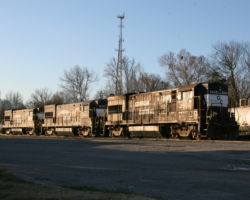
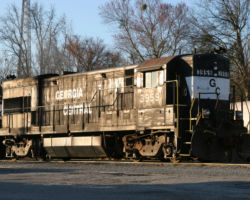
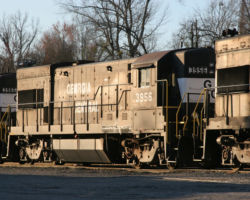
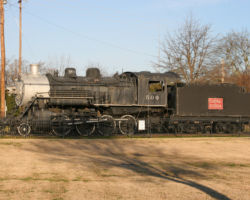
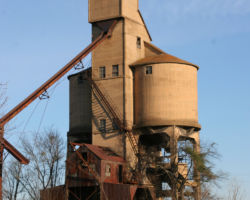
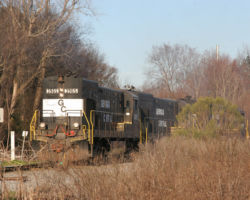
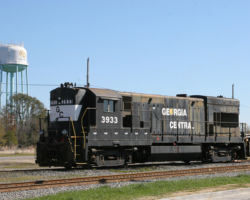
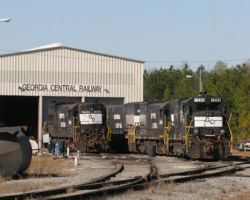
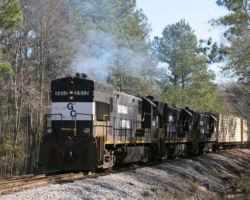
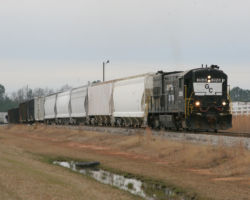
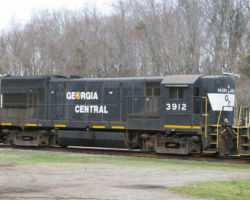
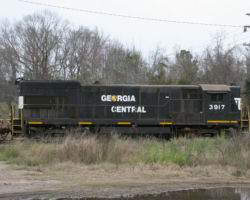
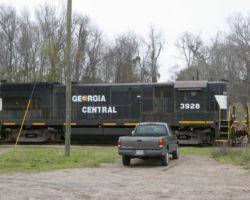
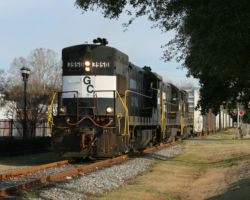
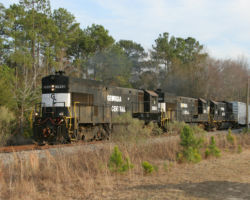
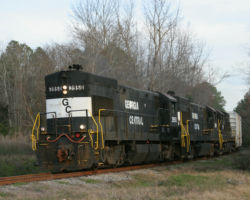
A Day at the Folkston Funnel – Wednesday, Jan 31, 2007
Since on Wednesday, 31-Jan-2007, I only had about a half day before needing to head to JAX for the flight home, I decided to stop at the famous Folkston Funnel. Folkston, a small town about four miles north of the GA-FL border on US 1, is one of the premier CSX hotspots of the south. All north-south CSX traffic going in or out of Florida passes through this point before the two former ACL routes diverge going north – one northwest to Waycross and Atlanta, and the other up the Atlantic seaboard via Jesup and Savannah.
The fine city of Folkston has traditionally billed itself as the “Gateway to the Okefenokee Swamp,” but several years back they recognizing that railfans were also naturally drawn to town. As such, they started promoting themselves to folks like us as well. The centerpiece of this is a viewing platform, constructed in 2001 on the east side of the tracks with an excellent view of the line. The platform has lights, fans, a built-in scanner with very good reception, and wireless internet access – particularly handy for reading Trainorders or loading up ATCSMon to figure out what’s coming your way. Once the sun moves through its zenith and trains become backlit from the platform, you can migrate to a park behind the old station, about half a block north and on the other side of the tracks. You won’t get that killer calendar shot from Folkston, but it’s a friendly, relaxing, comfortable place to watch trains where fans are welcome, and there’s plenty of CSX action to keep anyone entertained. Plus, it’s only 34 miles north of Jacksonville International Airport, so it’s a great place to blow part of a day while you’re waiting on your flight home. Remember they do this to attract more tourism, so be sure to drop a little money in town – lunch, gas, etc – to provide something in return for creating such a great place to watch trains.
The platform has actually had quite a bit of press coverage. Of the folks that stopped by while I was there, only three were really hard-core railfans. The rest were either curious as to what it was, or had a casual interest in trains and had seen mention of it either in USA Today or other major newspapers (such as here), or had seem a blurb done on CBS Sunday Morning back in May 2006. The Okefenokee Chamber of Commerce even promotes on it their website. It’s great to see a town that not only recognizes railfans but actively welcomes them as a form of tourist.
‘Twas a bit cold the day I visited, though, so I’d have to recommend going some time a bit warmer. The frequency of trains more than made up for it, though, and only in the couple of lulls did I really notice that I was freezing. I guess that’s a lesson for next time – bring something with long sleeves, and bring more than just a light jacket. In the five hours I was there, I managed to catch 22 trains. Trains down here will call out their symbol and lead motor as they call out signal indications. It comes in very handy for identifying trains, and now I finally understand how you Easterners seem to know the symbol of every train that runs past you. There are also detectors on both sides of Folkston, and they’re very loud and annoying on the platform scanner speakers, but at least there’s pretty much no chance you’ll miss a train. If that doesn’t rattle you out of your slumber, there are grade crossings on each side that will trigger before you can actually see the train from the platform. Just wait for the bells, if the horn and radio chatter don’t wake you up. I’ve included a sampling of what I managed to photograph – both in terms of trains and a few interesting freight cars that went past the platform.
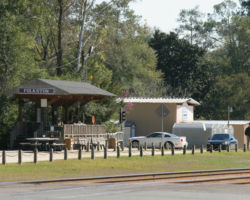
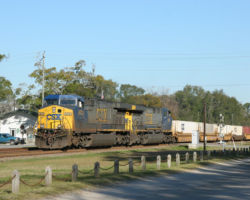
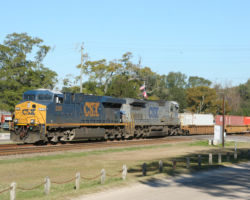
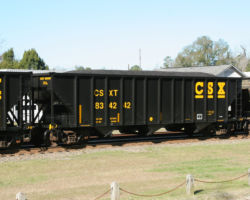
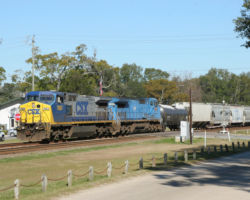
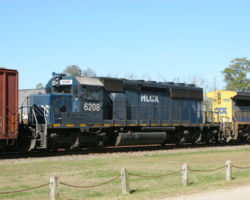
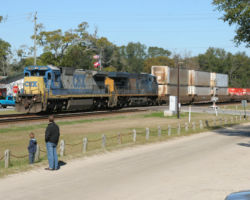
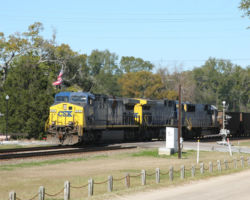
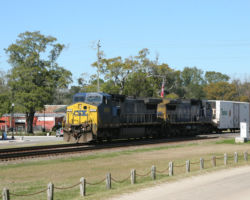
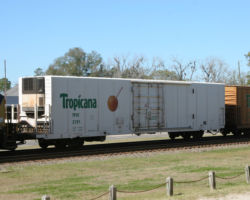
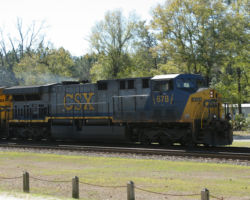
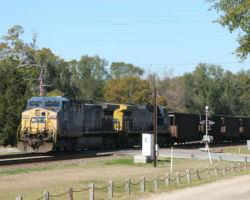
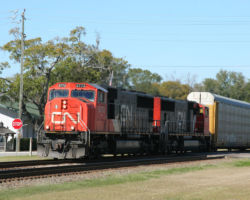
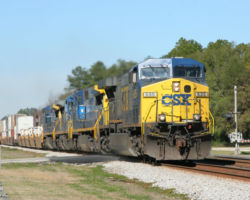
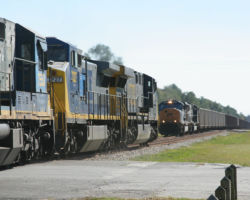
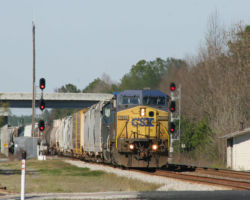
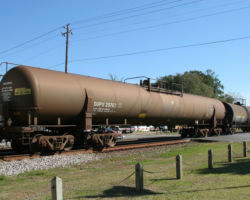
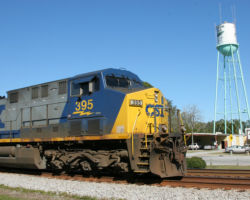
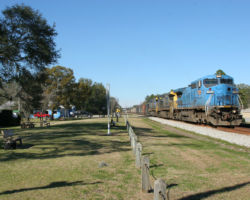
All photographs in this trip report were taken with a Canon EOS 20D using either a Canon 24-105mm F4 L IS/USM or a Canon 75-300mm f4-5.6 IS/USM.
This work is copyright 2024 by Nathan D. Holmes, but all text and images are licensed and reusable under a Creative Commons Attribution-NonCommercial-ShareAlike license. Basically you’re welcome to use any of this as long as it’s not for commercial purposes, you credit me as the source, and you share any derivative works under the same license. I’d encourage others to consider similar licenses for their works.
